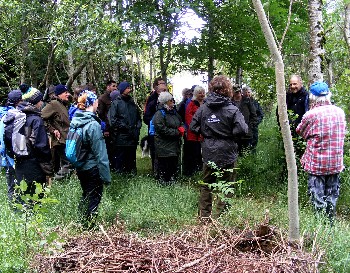Workshop highlights the potential benefits of woodlands for a diversity of other enterprises
Posted: Wednesday 26 July, 2017 @ 11:11:58

The Grazing, Trees and Trout workshop, organised by The Woodland Trust Croft Woodland Project, with support from Forestry Commission Scotland, was held at Aultbea and Mellon Charles on 24th of June 2017; and was attended by 35 people.
The workshop focussed on how woodlands can be integrated with other enterprises to improve the productive value of croftland and to improve the amenity value of townships.
Presentations from the morning session in Aultbea Village Hall, by Peter Cunningham, SWRFT Biologist (‘Feed the Land’); Donnie Chisholm, WT Croft Woodland Project Officer, (‘Growing Trees in Wester Ross’) and Iris Glimmerveen (‘Woodland Inspirations’) can be found via links on the downloads page of this website at Grazing, Trees and Trout http://www.wrft.org.uk/downloads/files.cfm?id=42.
Peter’s presentation focussed on the need to understand ecosystem fertility and for continuing to provide nourishment for young trees in areas where the ground is less fertile than it should be due to past land management practices. Young trees need people to care for them and feed them as they grow!
Donnie’s presentation outlined many opportunities provided by the Woodland Trust’s Croft Woodland Project, and how new woodlands can be integrated with sheep, cattle and other enterprises. Plans for ambitious new woodlands on common grazing land nearby were presented. The presentation concluded with a wonderful original poster ‘Trees in Wester Ross’ by artist Iona Chisholm.
Iris’s presentation focussed on woodland pastures and included examples of a wide variety of other ways in which woodlands can be integrated with other land uses to generate income and improving the value of land. There are lots of illustrations and ideas!
Subsequent discussion focussed on some of the grants available to crofters and the need for greater recognition by the Government agencies of the advantages of integrating woodlands with grazing.
Following the indoor session we explored a woodland croft by Mellon Charles. We sheltered from a strong westerly wind and from heavy showers of rain beneath a wonderful assortment of trees planted around 25 years ago by Bernard Planterose. Bernard returned to the croft for the first time since planting the trees to join the excursion.
Despite the wild weather outside, the croft woodland was full of life and of bird song (willow warbler, goldfinches, wren). We learned about hazel coppice, apple trees, and how fire can be discouraged from spreading onto woodland by removing heather around the trees. Much of the woodland floor is green and grassy.
From the wooded croft we headed up onto the higher ground. Donnie had cleared the path through the gorse bushes. We looked at young rowan trees that had been growing up through the gorse. With the wind behind, two of the participants headed for one of the hill lochs for a few casts; several trout were caught!
Where grazing pressure around the lochs has been lighter, various plants were found that are more typically associated with scrub-woodland than moorland, including honeysuckle, brambles and willows.
A small prostrate juniper bush was examined. Juniper berries are different from the berries found on plants like blaeberry. Juniper, like yew, is a conifer which produces a fruity wrapping from its cone around its seeds. Juniper berries take more than two years to form and ripen! Fieldfares and waxwings eat juniper berries and thereby help to disperse juniper seeds.
The group visited a nearby crag upon which the leaves of aspen trees were fluttering in the wind. Around the base of the crag, the ground is green and grassy, a favoured place for sheep. There are lots of blaeberry coming up beneath nearby bracken and heather.
Donnie told us more about plans to develop two areas of woodland within this area, and how the woodlands will be designed in ways that will support livestock management and in time can provide additional sources of nutrition (e.g. leaf litter and insects) for trout lochs within the area.
Thank you to the Chisholm family and friends for producing a wonderful lunch; to Alastair Mackenzie and Bernard Planterose for much information and enthusiasm, and to everyone else from near and far for making the event so informative and enjoyable.
Thank you to Forestry Commission Scotland for supporting the event.
For further information, please visit;
The Woodland Trust Croft Woodland project: http://www.wrft.org.uk/files/Croft%20Woodlands%20leaflet%20May17.pdf .
Woodland Inspirations website: http://www.woodlandinspirations.eu/ .